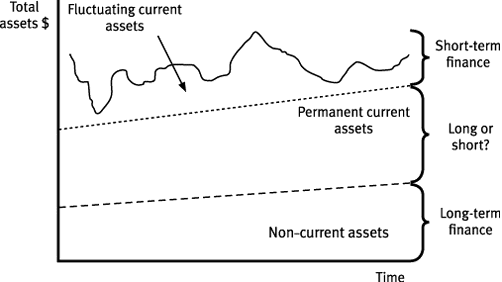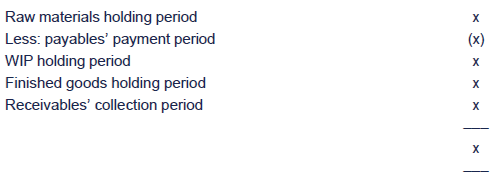Working capital management
Working capital is the capital available for conducting the day-to-day operations of an organisation; normally the excess of current assets over current liabilities.
Working capital management is the management of all aspects of both current assets and current liabilities, to minimise the risk of insolvency while maximising the return on assets.
The main objective of working capital management is to get the balance of current assets and current liabilities right.
Importance of working capital management
Current assets are a major financial position statement item and especially significant to smaller firms. Mismanagement of working capital is therefore a common cause of business failure, e.g.:
Working capital management is a key factor in an organisation's long-term success.
The balancing act: Profitability v Liquidity
The decision regarding the level of overall investment in working capital is a cost/benefit trade-off - liquidity versus profitability.
Unprofitable companies can survive if they have liquidity. Profitable companies can fail if they run out of cash to pay their liabilities (wages, amounts due to suppliers, overdraft interest, etc.).
Liquidity in the context of working capital management means having enough cash or ready access to cash to meet all payment obligations when these fall due. The main sources of liquidity are usually:
-
cash in the bank
-
short-term investments that can be cashed in easily and quickly
-
cash inflows from normal trading operations (cash sales and payments by receivables for credit sales)
-
an overdraft facility or other ready source of extra borrowing.
Cash balances and cash flows need to be monitored just as closely as trading profits.
Elements of working capital
Managing working capital involves managing the individual elements which make up working capital:
Funding strategies
In the same way as for long-term investments, a firm must make a decision about what source of finance is best used for the funding of working capital requirements.
The decision about whether to choose short- or long-term options depends upon a number of factors:
-
the extent to which current assets are permanent or fluctuating
-
the costs and risks of short-term finance
-
the attitude of management to risk
Permanent or fluctuating current assets
In most businesses a proportion of the current assets are fixed over time, i.e. 'permanent'. For example:

The choice of how to finance the permanent current assets is a matter for managerial judgement, but includes an analysis of the cost and risks of short-term finance.
The attitude of management to risk: aggressive, conservative and matching funding policies
There is no ideal funding package, but three approaches may be identified.
-
Aggressive - finance most current assets, including 'permanent' ones, with short-term finance. Risky but profitable.
-
Conservative - long-term finance is used for most current assets, including a proportion of fluctuating current assets. Stable but expensive.
-
Matching - the duration of the finance is matched to the duration of the investment.
A firm choosing to have a lower level of working capital than rivals is said to have an 'aggressive' approach, whereas a firm with a higher level of working capital has a 'conservative' approach.
An aggressive approach will result in higher profitability and higher risk, while a conservative approach will result in lower profitability and lower risk.
Over-capitalisation
If there are excessive inventories, accounts receivable and cash,and very few accounts payable, there will be an over-investment by the company in current assets. Working capital will be excessive and the company will be over-capitalised.
Overtrading
Cash flow is the lifeblood of the thriving business. Effective and efficient management of the working capital investment is essential to maintaining control of business cash flow. Management must have full awareness of the profitability versus liquidity trade-off.
For example, healthy trading growth typically produces:
In contrast to over-capitalisation, if the business does not have access to sufficient capital to fund the increase, it is said to be"overtrading". This can cause serious trouble for the business as it is unable to pay its business creditors.
The cash operating cycle
The elements of the operating cycle
The cash operating cycle is the length of time between the company's outlay on raw materials, wages and other expenditures and the inflow of cash from the sale of goods.
The faster a firm can 'push' items around the cycle the lower its investment in working capital will be.
Calculation of the cash operating cycle
For a manufacturing business, the cash operating cycle is calculated as:

For a wholesale or retail business, there will be no raw materials or WIP holding periods, and the cycle simplifies to:

The cycle may be measured in days, weeks or months. The holding periods are calculated using a series of working capital ratios.
Factors affecting the length of the operating cycle
Length of the cycle depends on:
The optimum level of working capital is the amount that results in no idle cash or unused inventory, but that does not put a strain on liquid resources.
Working capital ratios
Ratios to determine the operating cycle
The periods used to determine the cash operating cycle are calculated by using a series of working capital ratios.
The ratios for the individual components (inventory, receivables and payables) are normally expressed as the number of days/weeks/months of the relevant income statement figure they represent.
Inventory holding period
This ratio calculates the length of time inventory is held between purchase and sale.
Calculated as:

In some cases, a more detailed breakdown of inventory may be required. Inventory holding periods can be calculated for each type of inventory: raw materials, work-in-progress and finished goods.
Raw material inventory holding period
The length of time raw materials are held between purchase and being used in production.
Calculated as:

WIP holding period
The length of time goods spend in production.
Calculated as:

Finished goods inventory period
The length of time finished goods are held between completion or purchase and sale.
Calculated as:

For all inventory period ratios, a low ratio is usually seen as a sign of good working capital management. It is very expensive to hold inventory and thus minimum inventory holding usually points to good practice.
Trade receivables days
The length of time credit is extended to customers.
Calculated as:

Generally shorter credit periods are seen as financially sensible but the length will also depend upon the nature of the business.
Trade payables days
The average period of credit extended by suppliers.
Calculated as:

Generally, increasing payables days suggests advantage is being taken of available credit but there are risks:
Your FeedbackWe value your feedback on the topics or anything else you have found on our site, so we can make it even better.Give Feedback
Working capital liquidity ratios
Two key measures, the current ratio and the quick ratio, are used to assess short-term liquidity. Generally a higher ratio indicates better liquidity.
Current ratio
Measures how much of the total current assets are financed by current liabilities.

A measure of 2:1 means that current liabilities can be paid twice over out of existing current assets.
Quick (acid test) ratio
The quick or acid test ratio measures how well current liabilities are covered by liquid assets. This ratio is particularly useful where inventory holding periods are long.
A measure of 1:1 means that the company is able to meet existing liabilities if they all fall due at once.
Working capital turnover
One final ratio that relates to working capital is the working capital turnover ratio and is calculated as:
This measures how efficiently management is utilising its investment in working capital to generate sales and can be useful when assessing whether a company is overtrading. It must be interpreted in the light of the other ratios used.
Working capital investment levels
The level of working capital required (the financial position statement figure) is affected by the following factors:
-
The nature of the business,
-
Uncertainty in supplier deliveries.
-
The overall level of activity of the business.
-
The company's credit policy.
-
The credit policy of suppliers.
-
The length of the operating cycle.
The working capital ratios can be used to predict the levels of investment required. This is done by re-arranging the formulas. For example:

|
Created at 8/14/2012 2:44 PM by System Account
(GMT) Greenwich Mean Time : Dublin, Edinburgh, Lisbon, London
|
Last modified at 11/1/2016 4:27 PM by System Account
(GMT) Greenwich Mean Time : Dublin, Edinburgh, Lisbon, London
|
|
|
|
 |
Rating
:
|
 Ratings & Comments
(Click the stars to rate the page) Ratings & Comments
(Click the stars to rate the page)
|
 |
Tags:
|
|